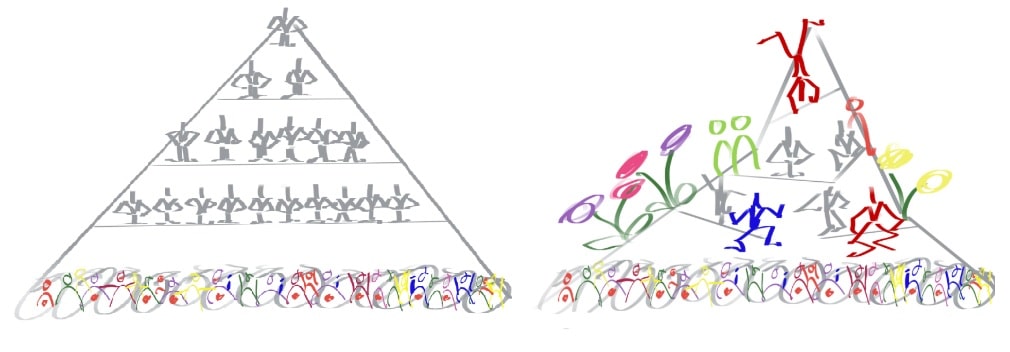The viral transformation
Table of Contents
“We have to pick up the employees where they are.” “We need an agile mindset.” Or, “We have to turn interested parties into participants.” Perhaps you have heard such or similar statements? In times when many companies are dealing with the topics of agility, transformation or change management, they are widely spread. Many managers have recognised that the behaviour and demands of customers and also of employees are changing. However, adapting an organisation to these changes does not work at the push of a button, not from top to bottom and not from now on at once. Simple recipes, typical phrases and prescribing change do not work.
The good news is: Many companies already have agile teams whose employees harmonise well with each other, value each other and gradually and successfully improve their working methods and results. The less good news is: Unfortunately, even in such companies it is rare for the mindset and approach to spread virally to the rest of the organisation. Why is this the case and what needs to happen for a viral transformation to occur?
Trim, pyramid!
A company is a system. Often employees in hierarchically structured systems find it difficult to question their own status and decision-making powers. They fear the loss of power and responsibility, of reputation and possibly also salary. If teams in such systems try to improve their environment on their own initiative while the rest of the organisation wants to maintain the status quo, tensions arise. Between the teams and the rest of the organisation and perhaps even as a result within the teams. So if you want an agile company, you have to offer room for development, you have to reflect and certainly also adapt yourself. Then there is a chance that the hierarchical system, the pyramid, will change. Structures can break open and new life can grow in the openings. Dialogue at all (management) levels becomes possible.

From the hierarchical pyramid to dialogue and more life
And what happens if we do not engage the leadership in a dialogue, if the structures, processes and behaviour of the organisation simply remain as they are? At some point the tension becomes too great. Borders bend and break. The pyramid “falls” to the ground, agility dies.

The pyramid collapses.
Dialogue across all levels
What do we want as an organisation? And who wants what and why? The conscious development of an organisation is a process. A process of cooperation. A process of communication. If you seriously want to transform your organisation into a resilient, agile, learning organisation, you have to involve all people at all levels. This cannot be achieved in the form of a kick-off meeting, where the management is telling stories about the dawn of new times and presenting its vision. A vision must be developed together, not on the back of the employees, but together and continuously with you. It makes much more sense to regularly involve employees in feedback cycles. A very good option for this are retrospective conversations on all levels. These can start with a simple question:
- “What do you need from me in terms of leadership to get to where you want to go next?”
- “How can I best support you?”
- “How do you wish me to change?”
Leadership is an essential aspect of corporate change. If the management wants to transform the company into a learning organisation – the motivation behind this may also be monetary – then practice shows that it is much more effective to start with oneself. As humans we tend to think “your” way. “You have to do this!” “Why didn’t you do that?” Often such statements imply accusations and provoke defenses. Even without the desire for change in an organisation, this leads to negative thoughts, perceptions and behaviour. But if you want to actively promote change, you should think in “we” terms. And say “we”. And start with change in your own mind. This is a first step to which colleagues and employees feel invited. This is the opposite of confrontation, it is the common conversation with respect and compassion.
Alternatively, there are of course also organisations where the conversation also starts “from below”: “We need this from you to move forward faster … and if you play along in this way, it has the following advantage for you …”. (By the way, this example shows that despite respectful interaction, clear announcements and statements are still possible. Respect and clarity are not mutually exclusive, neither are criticism and compassion).
The viral way
Have you ever wondered why a posting in the social media goes viral? Why a video with clumsy kittens gets more than 10.000 likes? Even if it’s not obvious at first glance, such hits rarely start right from the beginning. Often the content is on the move for several weeks, months or even years. There are of course viral hits that attract a lot of attention overnight, but in most cases it behaves differently. So if you want to achieve viral success, you should take a look at the success factors. For example, they should ask themselves whether they need advocates and whether they know promoters, how content is prepared and which simple messages are conveyed. And what does this mean for the resilient, agile, learning organisation you want? What are the factors in your environment that are essential for change in your environment? How do you create the basis – far away from easy sounding phrases like “We have to break open silos” or “We have to work with resistance”. – for your transformation? What can you do for your viral transformation?
In my practical experience, I have found that explicit leadership agreements are a very good way to support an organisation in its transformation. They help all those who want to consciously improve their relationships with others in the organisation, in order to improve the organisation as a whole in continuous steps. Explicit leadership agreements can be concluded between managers, between managers and their employees and also between colleagues. The following contents, among others, can be discussed and agreed upon:
- How do we want to lead each other?
- How do we want to help and support each other?
- What do we need from each other specifically in the near future, what help or support?
- Who will help us to make this agreement binding in everyday life?
- When will we review and update this agreement?
Very often participants report greater clarity, understanding and self-confidence immediately after their first agreement. For me this is a good sign, because every consciously initiated transformation needs clarity and understanding. And besides clarity and understanding, what else is missing as a basis for successful, lasting change in a company? Trust. But that is a topic for another blog post.
Notes:
Olaf Lewitz helps managers and organisations to promote growth. Together with Christine Neidhardt, he created the TrustTemenos Leadership Academy, which helps you to become the leader you want to be in a 10-month program.
Olaf Lewitz has published another post in the t2informatik Blog:

Olaf Lewitz
Olaf Lewitz is Trust Artist and Certified Enterprise Coach of the Scrum Alliance. In the TrustTemenos Leadership Academy he offers training and workshops on leadership with intention, trust, mentoring and coaching.
